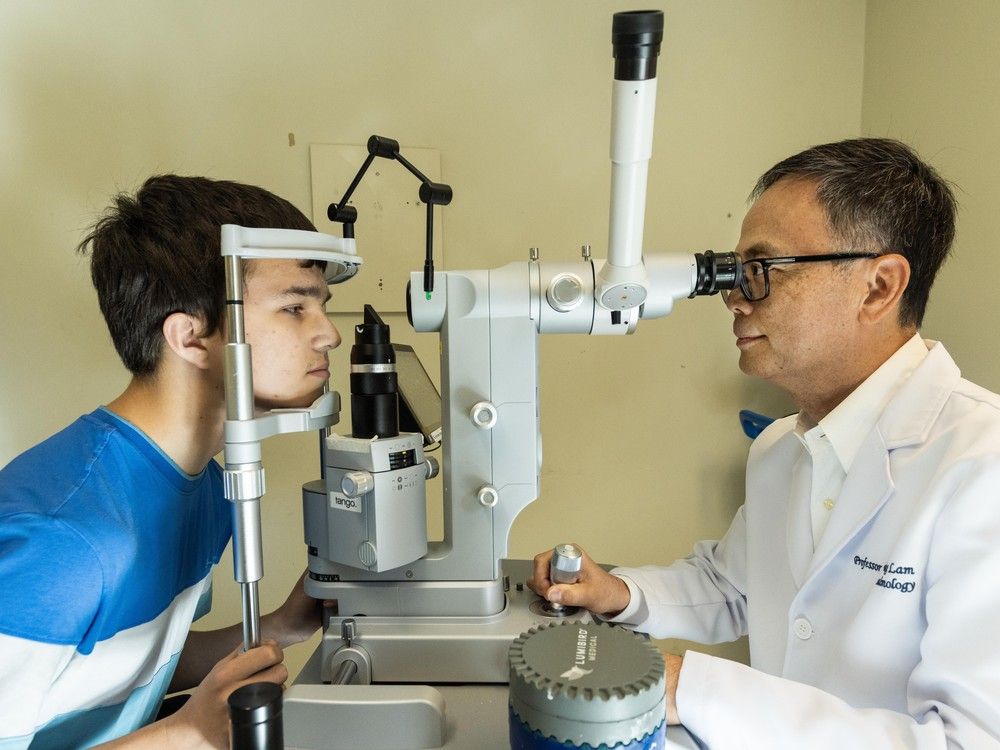
As an infant, Dominic Juillette was always looking for light.
“When his father carried him past a lamp, he would turn his head toward it,” said his grandmother, Linda McInnis. She knew from the time he was a baby that something was different.
The Fort St. James youngster, now a 15-year-old Grade 11 honour roll student, has Leber congenital amaurosis, a rare, progressive genetic eye disorder that has affected his vision from birth. The disorder, which affects the retinas, is caused by genetic mutations in the RPE65 gene.
Without treatment, he would have eventually gone blind.
The journey to solve the puzzle took years, the dedication of his family, the commitment of three enterprising doctors in Vancouver, and a new $1.5 million optical coherence tomography microscope funded by the VGH & UBC Hospital Foundation.
“We were always coming down to Vancouver,” said McInnis.

When ophthalmology geneticist Dr. Kevin Gregory-Evans ordered genetic testing that revealed the problem, he worked with doctors Wai Ching Lam and Zaid Mammo to secure the diagnostic equipment for a full testing through the B.C.’s expensive drugs for rare diseases program.
“After that we just bobsledded into treatment,” said McInnis.
Dominic is one of the first two patients in B.C., and the first Indigenous patient in Canada, to receive the targeted surgery and gene replacement therapy.
The surgery, performed by Lam and Mammo, replaced the faulty gene in each of Juillette’s eyes with a gene that has functional photo receptors for vision in the dark.
“This is a progressive condition,” said Lam. “People with this condition have difficulty with night vision and problems with light sensitivity and eventually their whole vision.”
For the first time, Dominic is experiencing life after dark.
He not only can see like everyone else, he feels like everyone else.
“My confidence is growing,” said Juillette, who admits he was a bit skeptical before the surgery.
But after a lifetime of progressively declining vision, improvement was almost immediate after the one-hour operation on the first of two eyes. Things were suddenly bright. And so is his future.
“I have so many more opportunities now,” he said.
Juillette is not the kind of kid who wants to draw attention to himself. Really, he just wanted to fit in.
For years, he needed a special desk at school, as big as a dining room table, covered with magnifiers and special lighting equipment. The doors to his classrooms had to be framed in bright colours so he didn’t bump into them.
On camping trips, when the sun went down, and other kids started having fun, he would go to sleep, because he couldn’t see.
Since the surgery, he went to his first after-dark beach party at Cultus Lake. He went camping with his grandmother and saw the Perseid meteor shower. And he zips to school on a new scooter.

Lam and Mammo replaced the gene in each of Dominic’s eyes with one that has photo receptors for vision in the dark using the new microscope to perform the precise injection under the retina.
Gene therapy works by delivering a “correct” copy of a gene into the body — usually using a vector, like a virus, to deliver the working gene to the area that has the defective gene. The goal is to get enough cells working correctly that the body can function normally or better manage the disease.
“In Dominic’s case, in the centre part of his vision he has the defective gene, so he is not able to make that specific protein that is required for the vision. The treatment uses a vector to introduce the new gene to the host gene and infect the host cells so it can start producing the correct protein and the vision cycle is restored,” explained Lam.
Leber congenital amaurosis affects about one in every 50,000 people, said Lam. He credits Dominic’s family for their dogged pursuit of an answer, and the outreach they are doing to help spread the word to rural and remote communities where children with low vision might not know this treatment is available.
Health Canada approved the first targeted gene therapy used to treat the disease, and B.C. approved coverage of the therapy under public health insurance in 2023. This retinal gene therapy surgery has also been performed in other provinces, including Alberta, Ontario, and Quebec.
“This is a big province, and we need to get the word out that this is available now,” said Lam. “It’s important that the surgery is done early, before too much of the vision is lost.”